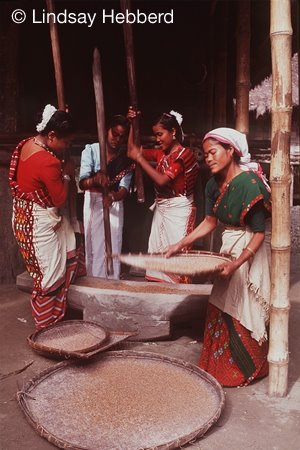
Films in Karbi, Bodo and Monpa. Films on witch-hunts and polyandry among yak shepherds Militant diktats against Hindi cinema are ushering in a revolution, says TERESA REHMAN
RAJEEV DOLEY laughs as he says, “What Amitabh Bachchan is to Bollywood, I am for tribal cinema in the Northeast.” Doley is the handsome star of Migan, the first film to be made in the Mishing dialect of Assam. Based on a Mishing novel by Indreswar Pegu, the film is about a young man who goes to Tibet in search of a Yoksa, a famed and powerful sword. Doley also stars in Ayang Ago, a commercial film with a love triangle involving a village boy and a city girl. After the films’ release Doley was so popular that political parties were ready to offer him a ticket for the assembly polls.
The Mishing community, which had grown used to watching Hindi and Assamese cinema, has longed to watch films in their own language. “Women, children and even village elders come to see me. They found it incredible that there was a film in their own dialect. People walk miles to the mini-video halls to watch my hits,” Doley says.
Amongst tribes in northeast India, literature and culture is passed on primarily through oral traditions, but films in tribal dialects that reflect their social and cultural ethos are also becoming an important tool. Doley believes his films are also helping to conserve the tribal culture for future generations.
Gautam Bora’s film Wosobipo (Cuckoo’s Call), a film made in Karbi, was probably one of the first few of its kind. It explores the lives of tribal farmers in Karbi Anglong, and their alienation from a new market economy. Bora says, “I did a lot of research and my film reflects unknown aspects of the Karbi tribe. The film serves as a document as Karbi language and literature is still in a nascent stage.”
Since the closure of cinema halls in the region, partly due to militant diktats against Hindi films and partly because of the emergent VCD culture, the film industry in Manipur has been doing brisk business in the VCD format — in cinema halls, on cable networks and in video parlours. In Assam too, video films have opened a window into a new world, where the box-office no longer dictates terms.
These films weave together folk tales and modern themes in a way that has caught the imagination of the tribal population. Enlivened with tribal costumes, dance and music, they also offer an exotic package that is making a mark worldwide. Sonam, a film on polyandry among yak shepherds was a big-budget 35 mm cinemascope production. The first feature film made in Monpa, a dialect of the Indo-Tibetan language of Arunachal Pradesh, it was in competition at the 37th International Film Festival of India in 2006, and was telecast on National Geographic
However, with only one cinema hall in Arunachal Pradesh, screenings are hard to organise.
Some of these films enter into a unique dialogue with the audience. Women in remote corners of Tripura would start crying while watching Mathia, a 2004 film about witch-hunting, made in the Kokborok language. Villagers even started shouting “Witch!” whenever they saw its lead actor Meena Debbarma. The 132-minute long Mathia is one of the first full-length digital feature films in the country and the first one set in northeast India. The film has won much acclaim and Debbarma was a jury member for the 53rd National film festival.
The newfound glory has not come without its share of difficulties. The crew of Sonam had to hike up to a height of 15,000 feet. And Joseph Pulinthanath, director of Mathia, undertook a three-hour trek through a river with six tonnes of filmmaking equipment, loaded on eight buffalo carts. Pulinthanath says, “We had to break the first shooting session due to incessant rains and an inundated river. In fact, one crew member succumbed to malaria during the shoot.”
FILM CRITIC Arun Lochan Das too feels that films made in tribal dialects are important tools that aid the understanding of tribal culture and community issues. “The government should grant subsidies for the making of such films and help promote them,” he says.
Yet, it is also important to recover the money invested by financiers and filmmakers have been trying to do so in innovative ways. During the Puja season, Pulinthanath lends out CDs of Mathia to be screened in remote villages. Audiences too have not disappointed them. Residents of the Bodo dominated areas of Assam throng the touring halls whenever a film in their language is screened. In fact, fired by the challenge, Jwngdao Bodosa had made the first Bodo film, Ala Yaron, which was a big hit in 1986. He is currently working on an English-Bodo film titled Golden Cocoon. “I wanted to showcase the silkworm-rearing tradition of the Bodos,” he says, adding that 70 percent of the film will be in English and 30 percent in Bodo.
Tribal cinema, however, remains a largely unchartered area. “There is a lot of originality here and hundreds of ways to tap into it, instead of turning the film into a mere commercial product,” says Bora. Fortunately, there are several enthusiastic filmmakers in the northeast now who are more than willing to rise to the challenge.
[ From Tehelka Magazine, Vol 5, Issue 22, Dated June 07, 2008 ]

No comments:
Post a Comment